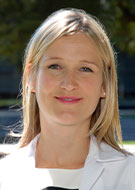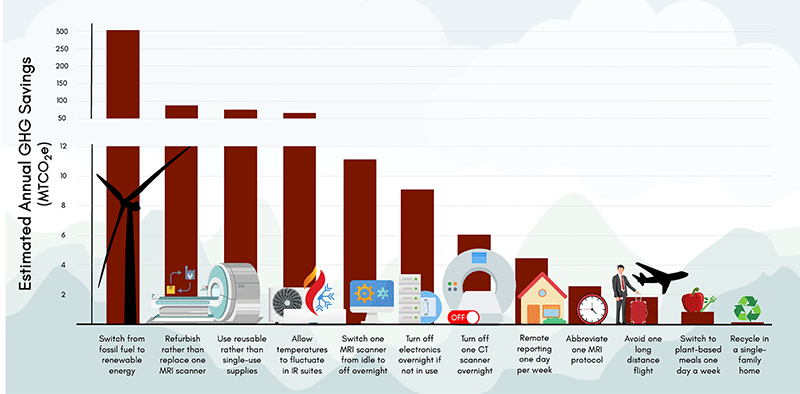Radiologists Propose Actions To Combat Climate Change
Sustainability teams must think creatively to make the most impact in their own departments

A diverse writing group—lead by authors at the University of Toronto—has developed an approach for radiology departments and practices to reduce their greenhouse gas emissions and become more resilient to the effects of climate change. They outlined their action plan in a Radiology in Focus article, published in Radiology.
“Rising greenhouse gas emission levels lead to climate change, extreme weather events and worsening air pollution with downstream adverse health effects,” said lead author Kate Hanneman, MD, MPH, vice chair of research and associate professor at the University of Toronto and deputy lead of sustainability at the Joint Department of Medical Imaging, Toronto General Hospital. “The goal of this article is to increase awareness of the interconnected relationship between planetary health and radiology, emphasize why radiologists should care about sustainability, showcase actions that can be implemented to mitigate our impact and prepare departments to adapt to the effects of climate change.”
Burning fossil fuels and other human activities that increase atmospheric greenhouse gas levels are the primary drivers of climate change. Radiology, through the production and use of medical imaging equipment and related supplies, is estimated to generate up to one percent of overall emissions.
“We propose a coordinated approach and concrete actions radiologists can implement to help sustain the health of the planet and, in turn, improve the health of their communities and patients,” Dr. Hanneman said.
The authors suggest radiology departments begin by establishing a sustainability team and dashboard to track and measure key metrics and performance indicators.
“Departments should build a diverse team that includes all key stakeholders, including radiologists, technologists, leadership, IT and facilities management,” she said. “The individuals and groups impacted by policies and protocol changes should be part of the conversation from the beginning.”

Graph of actions to reduce greenhouse gas (GHG) emissions in descending order of annual GHG emission savings. Estimates related to long-distance flights, plant-based meals, and recycling reflect personal choices and are included for perspective, to put the radiology-specific estimates in context. All other emission estimates relate to medical imaging departments. IR = interventional radiology, MTCO2e = metric tons of carbon dioxide equivalents.
https://doi.org/10.1148/radiol.232030 © RSNA 2024
What Can Radiologists Do to Improve Sustainability?
Recommended high-impact interventions to improve sustainability in radiology include transitioning from disposable to reusable medical supplies, turning off climate-control systems in unoccupied areas and powering down equipment when not in use.
Dr. Hanneman said that by switching scanners off or to lower power states when not in use, overall greenhouse gas emissions can be reduced by up to 33% for MRI and between 40% and 80% for CT. Optimizing scanner scheduling can also reduce idle time and reduce the average greenhouse gas emissions per exam for MRI and CT units.
“Utilizing one CT scanner 24/7 with minimal idle time is more efficient than utilizing three scanners from nine to five,” she said.
Another potential action is to implement decision-support tools to choose lower-energy imaging tests when appropriate. Carbon dioxide equivalent, or CO2e emissions, vary by imaging modality and are higher for MRI and CT compared to ultrasound and X-rays.
“When more than one imaging test is appropriate to answer a clinical question, imaging tests with lower emissions can be prioritized,” Dr. Hanneman said.
The authors also suggest abbreviating imaging protocols and expanding the use of clinical low-field MRI applications.
“Expanding clinical low-field MRI application will not only decrease use-phase emissions, but it can also potentially improve global access to MRI,” she said. “Low-field MRI units tend to be smaller and less expensive, and there’s growing recognition they can help address health inequities.”
The authors also recommend working with manufacturers to update or refurbish equipment rather than purchasing new imaging equipment, when feasible. To reduce packaging waste, the authors suggest switching from single dose to multi-patient contrast injection systems and to establish sustainable waste management programs.
“The familiar concepts of reducing, re-using and recycling can be applied within radiology,” she said.
Dr. Hanneman said the team’s recommendations are not intended to be one-size-fits-all.
“Not all of the suggested actions will be applicable or feasible to implement in every radiology department,” she said. “Sustainability teams will need to think creatively to determine what actions will have the greatest impact in their department.”
The article was part of a special sustainability-themed issue of Radiology in honor of Earth Day. Two other sustainability-themed articles were published. The first, “Energy and Greenhouse Gas Emission Savings Associated with Implementation of an Abbreviated Cardiac MRI Protocol” demonstrates ways to adjust MRI practices to reduce greenhouse gas emissions. The second article, “Contrast Media Driven Anthropogenic Gadolinium: Knowns and Unknowns” discusses how MRI contrast agents have been introduced into the environment and documented in water systems.
For More Information
Access the Radiology article, “Planetary Health and Radiology: Why We Should Care and What We Can Do.”
Read previous RSNA News stories about climate change: